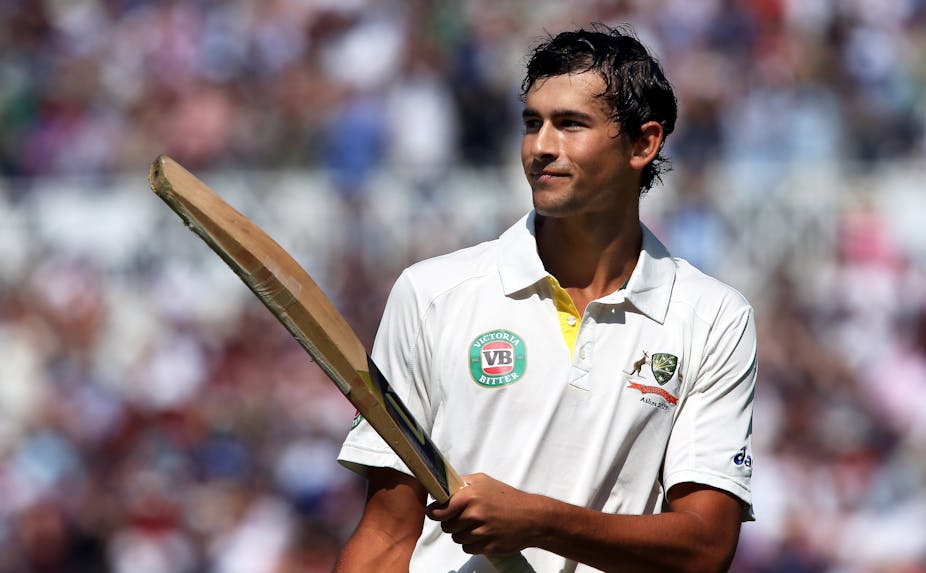Cricket fans worldwide are in awe of the talented teenager that threw Australia back into the ring to contest the first Ashes Test at Trent Bridge.
Melbourne cricketer Ashton Agar chalked up 98 runs in tough circumstances as the No.11 batsman. His batting partner Phil Hughes, who appeared to feed off Agar’s enthusiasm for a run-scoring fest, was rock-solid and generous in helping Agar savour his special Ashes debut. Facebook and Twitter went into overdrive, as Australians became enthralled by this fresh, young talent. The nation asked: “Who is Agar?”
While Agar is a dream for journalists and headline writers, thanks to his “pun-loving” name, the 19-year-old batting whiz played like he was challenging his teenage brothers to a game of backyard cricket.
It showed on his smiling, happy face. Agar was carefree, relaxed, courageous and importantly, he was having fun. Agar played his shots all over the ground, without hesitation. His skills came naturally, without a second thought and without the burden of pressure.
Agar was instructed to play his own game – and that’s exactly what he did. His love of the game, with its challenges and bat-angling techniques, was evident as he literally … pushed the boundaries.
So why can’t all Australian cricketers bat with the same carefree spirit and graceful shots?
While most established cricketers carry baggage – or psychological inhibitors which restrict them from playing well consistently – Agar has a pure outlook on cricket.
His attitude reflects the innocence of an unaffected player, who isn’t burdened by outside pressures. Agar was in “the zone” during his record-breaking innings. It was as if he was playing his brothers Will, 17, and Wes, 16, in the family’s concrete driveway.
It’s evident that Agar has played thousands and thousands of shots against his brothers’ bowling at home. It’s like he has relived every angle of the pitched ball, and then he executes each shot in automated skill mode. While Agar’s close-knit family has kept him modest and happy, there’s no replacement for the hours of free play where skills develop. Experts say the golden years of learning occur between the ages of six and ten. This is when most of our skills are formed. Free play, or informal practice, gives young athletes a blueprint for a future in elite sport.
Agar’s constant exposure to cricket practice has formulated a skill-set that withstands outside pressures. But it doesn’t stop there. Agar, who has deferred a university law degree, has high intelligence who understands that results come with “no fear” and playing with “freedom”. His intelligence played a role in his decision-making and also, it allowed him to play his shots without muscle tension inhibiting natural execution.
Agar was free as a bird at Trent Bridge yesterday, as his exhibition of tenacious run-scoring was appreciated by the parochial British-strong crowd. If he can maintain that free spirit, while bowling and batting, Agar will be an asset for Australia.
Agar’s home practice routine is reminiscent of cricketing legend Sir Don Bradman’s play time. As a young boy, Bradman used a cricket stump for a bat and a golf ball to master his shots against a water tank stand. This allowed Bradman to anticipate the golf ball at high speed – on a thin surface - as it ricocheted off the brick. It highlights the need for conditioning in a young athlete’s formative years to allow skills to be automated.
Agar has all the makings of a long-lasting champion, but the overriding quality will be dictated by his lessons in the home. His success is a reflection of good parents who nurtured their sons’ talents on the cricket field. Agar’s father, John, was a former state cricketer who provided an athletic outlet for three energetic sons. Agar’s height is a massive advantage, as his long levers (arms and legs) allow him to produce power through his shots.
Sibling rivalry can sometimes be a blessing, which can generate healthy competition within a family as they push themselves to excel. There are many examples of women who have become great athletes because they competed with their brothers in the backyard. The stories of backyard bliss are common in sporting families. Competitive play is healthy to express the human’s desire to win and improve in a testing environment. This is where Agar built the foundation for his career in Test cricket.
Good school and club environments have further nurtured Agar’s talents. De La Salle College, where Agar was a high-achieving scholar, is renowned for its competitive sporting programs, giving athletes a chance to experience the best of school sport in Melbourne.
Time will tell how Agar responds to the hype surrounding his Test debut in the form of consistent performances. But all the signs are clear: Agar has the makings of a champion – and he’s enjoyed a champion home to realise his dreams in professional cricket.

